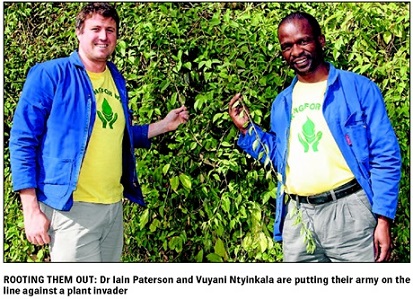
IN A move that would give even the best sci-fi thriller a good run for its money, an Eastern Cape scientist unleashed an army of unlikely soldiers yesterday to wage biological warfare on a pesky enemy.
The theatre of the onslaught is a pristine stretch of Eastern Cape coastline where an alien of the green kind has been targeting indigenous plant species.
In a first for the province and South Africa, Rhodes University lead researcher Dr Iain Paterson's force of pereskia stem-wilter bugs will be let loose to wreak biological destruction against the invasive cactus genus pereskia, which flourishes in difficult-to-access and ecologically sensitive areas.
Armed with an insatiable appetite for the pereskia plant, the bugs —which are the biological control agent for pereskia — were released in a ceremony held at the university late yesterday.
The Department of Agriculture, Forestry and Fisheries granted permission to release the pereskia stem-wilter (Catorhintha schaffnen
"Using herbicides and physical removal is difficult because of where the plant grows," Paterson explained. "The plant can also reproduce from small fragments; so after clearing operations the tiny fragments left behind will grow into new plants.
"The weed grows intertwined with indigenous plants, so pereskia cannot be removed without killing indigenous plants too."
This is where the bugs come in: they feed on the shoot tips of the pereskia and are damaging to the plant, making them the ideal biological control agent.
Sufficient numbers of pereskia stem-wilter have been reared and are ready for release.
The bugs have been moved out of quarantine and mass rearing efforts are under way at the Waainek greenhouses in Grahamstrown. The pereskia stem-wilters are fed plant cuttings from infestations growing around Grahamstown.
"After many years of research it is clear the pereskia stem-wilter can only survive on pereskia and will die if it is forced to feed on any other plant.
"If the insect is given a choice, it will always choose to feed on pereskia. This means that if the pereskia stem-wilter is released in South Africa it will feed on pereskia only and will not harm any indigenous plants or crops," he explained.
The insect is native to Brazil and prefers the warmer conditions of South Africa's north-east coastline, which is ideally suited as pereskia is causing the most damage in these regions.
"We hope to release about 300 at each site that we identify. And the sites are all the way from Port St Johns to about Kosi Bay," Paterson said.
Unlike herbicidal and physical removals, biological control is environmentally friendly and sustainable, the scientist says.
This is a long-term solution and only damages the target weed, not the surrounding vegetation.
Mass rearing efforts will also take place at the SA Sugar Research Institute and releases will be made at sites infested with pereskia throughout the country.
Pereskia (pereskia aculeata) is an invasive alien plant that was brought to South Africa in 1858 as a botanical curiosity.
It destroys South African native biodiversity by smothering indigenous plants and killing large forest trees which collapse under the weight of the weed. Infested forests become degraded ecosystems with low levels of biodiversity. ROOTING THEM OUT: Dr lain Paterson and Vuyani Ntyinkala are putting their army on the line against a plant invader STARS OF THE SHOW: Two pereskia stem-wilter bugs feasting on the enemy
Article by : Xolisa Phillip
Article source : Weekend Post(sunrise).
